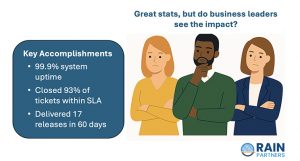The Challenges of Aligning IT and the Business

“IT alignment” has been for some time, and continues to be, a major challenge for IT leaders. This idea of “aligning” the IT group with the rest of the organization is a persistent puzzle that causes many IT leaders to lose sleep.
And yet, despite the unrelenting attention to this topic from a vast array of consultants and others, a clear working template or solution doesn’t appear to be any more evident.
So what’s the problem?
I’m hardly the first person to ask this question. And a quick review of the major approaches to this question yields two different types of answers:
1. IT alignment is a fictional concept looking for a practical solution. Forget about alignment per se and get back to work.
2. IT alignment = __________. And depending on who you are, what goes in the blank differs. For some, we hear that IT alignment = aligning with the customer, for others IT alignment = a call to focus on delivering the solutions the business community wants and needs.
Clearly neither of these approaches is satisfactory because IT leaders are still complaining about alignment issues.
Obviously I have some thoughts about what IT alignment is all about, otherwise I wouldn’t be writing this article. But rather than jumping straight in and sharing them with you, I want to share with you where they come from and how they evolved. I believe the genesis of these ideas matters more than my particular take on what IT alignment is all about. Without the context, it may feel like just another checklist and you will have missed the point entirely.
My journey in search of aligning IT with the business
I’ve worked with scores of senior IT leaders over the last 25-plus years on issues of IT strategy and alignment. In my early days, I thought I knew what people meant when they said they needed help with alignment. And like so many committed IT consultants, I followed the typical methodologies of the day for connecting (note I say connecting not aligning) my clients’ IT projects with their companies’ strategic business objectives and initiatives.
It felt good. It felt right… at first. But within six months these same clients again brought up the issue of not being aligned with the business.
With a little humility born out of a less-than-perfect outcome with the clients, I began to ask some pointed questions such as:
*What do you mean when you say “not aligned”?
*When do you experience this sense of the absence of alignment?
*Do all the IT folks feel this way or is it just a few? What do they have in common?
*Does the business community feel the same way about IT?
The answers I received to these questions gave me one of those “ah ha!” moments.
You see, I expected to get a relatively stable set of answers; a few variations on a key theme or two. Instead, I got answers that were all over the map.
And that’s when I realized that the issue of aligning IT isn’t really a clear-cut business, IT or management problem, it’s a feeling that people experience. And different people experience that feeling in different ways depending on their unique organizational circumstances.
A shift in understanding
Once I shifted my thinking to the feeling domain, it became so much easier to understand what was going on.
Instead of asking about the specifics of the problem, I asked people to describe what they were feeling—to describe the feeling of “misalignment.”
And that’s when the responses began to coalesce.
Here are some of the most common descriptions of this “misalignment” feeling I have heard over the years:
*“I feel disconnected from my peers.”
*“ IT isn’t really part of the company.”
*“We are not accepted as part of the team, our contribution isn’t appreciated.”
*“Our colleagues don’t understand what we do or care much about it.”
*“I feel like we are always playing catch up, running after an older brother who can’t be bothered to play with us.”
*“We’re always the last to know.”
My big discovery
And here’s the “ah ha!”: Although the feelings were very similar across organizations, what gave rise to those feelings varied greatly.
In one case, the IT group was suffering this sense of “misalignment” because it was trying to allocate IT costs in a way that was completely out of sync with how the finance department approached cost allocation.
In another case the “misalignment” feeling came from implementing a low-cost, low-touch support model that was very much at odds with the high-touch customer service orientation of the company as a whole.
In still a third case, the “misalignment” feeling came from attempting to build regional IT support processes when the business fundamentally operated on a very local level.
More importantly, any attempt to force one solution to the “misalignment” symptom is likely to fall short and in fact has.
That’s why, in my humble opinion, we are still talking about alignment after all these years. Because everyone has been looking for the answer when the fact of the matter is that there isn’t one answer. I believe one of the main reasons everyone has so much trouble with alignment is because it’s viewed much too narrowly.
Now, to the solution
Once I understood that there wasn’t a single answer, I began to take a close look at the variety of issues that gave rise to the feelings of “misalignment.” And to cut a long story short, here is what I learned:
Each organization has its own unique IT alignment needs—its unique IT alignment fingerprint.
You see, just like a hand has five fingers, not all hands are the same. Each has its own unique set of fingerprints. So it is with IT alignment. There are five fingers or areas where IT is susceptible to misalignment. And depending on the company and situation the feeling of “misalignment” can come from one or more of these areas.
Here are the five areas of IT alignment, along with a practical perspective for identifying alignment problems and opportunities.
The 5 areas of IT alignment:
1. Strategy-Driven Alignment: This is the area most commonly associated with alignment. And it’s also the most misunderstood.
Strategy-driven alignment refers to three things: (1) that the IT project portfolio directly meets the wants and needs of the business community; (2) that IT projects and budget can be directly tied to the company strategy; and (3) that IT investment (where appropriate) forms part of the core strategy of the company.
2. Operational Alignment: Central to this element is the IT group’s adoption of an operating model for delivering services and support that meshes with the way the company works as a whole. Plainly put, if strategy-driven alignment is about what is getting done, operational alignment is all about how it gets done. In particular, how IT services are delivered.
3. Calendar Alignment: Calendar alignment is about getting “in sync” with the recurring calendar, pace and timing of the organization overall. Simply stated, calendar alignment means dovetailing three interrelated areas of organizational activity: (a) The IT vision, strategy and budget calendar; (b) the “big event” corporate calendar; and (c) the operational calendars of the key areas of your organization.
4. Economic Alignment: Economic alignment refers to the set of budget allocation, tracking and reporting activities and how they mesh with the understanding and presentation of costs within your organization. Since IT is forever presenting projects and budgets—many of which are allocated to a number of groups—economic alignment is required to ensure that everyone is speaking the same cost language. Sounds simple, but it’s not. IT often needs to track and manage costs differently than other areas and this need can cause profound disconnect.
5. Cultural Alignment: Companies have personalities, and so do the departments within them. Corporate personalities arise from combinations of so many soft qualities that it’s difficult to quantify or define them outright. But one thing’s for sure; you know it when you see it. Cultural alignment means being sensitive to (1) the big picture attitudes of the company to technology and technology-related issues; and (2) the personalities and fit of the IT personnel as members of a larger group.
Your challenge: What is your company’s IT alignment fingerprint
Conventionally, achieving alignment has been oversimplified to mean “the selection and delivery of the right projects.” And while that’s important, there’s clearly more that IT leaders need to consider in order to achieve that often elusive feeling of alignment.
Try out the above approach, and let me know how it goes.


